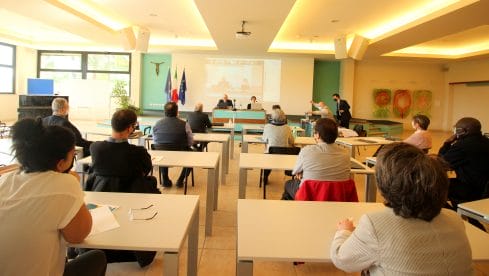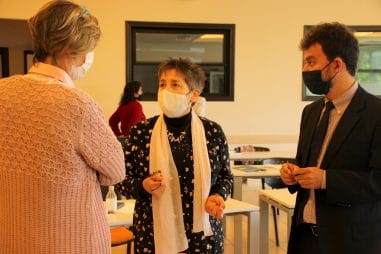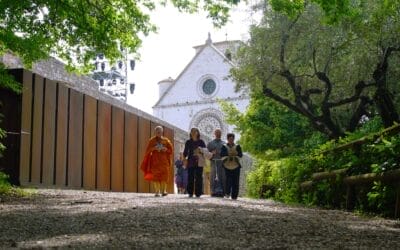This is the term used by the Ecumenical Patriarch of Constantinople, Bartholomew I, in his message to the participants in the meeting of the Patriarch Athenagoras-Chiara Lubich International Ecumenical Chair, to define Pope Paul VI, Patriarch Athenagoras and Chiara Lubich, who are the focus of this third event, jointly organized by the Sophia University Institute and the Ecumenical Patriarchate of Constantinople on 25 and 26 May.  The title of the third meeting of the international ecumenical chair was “Pope Paul VI, Patriarch Athenagoras, Chiara Lubich – Prophecy of unity between the sister Churches ”. The “Chair” was jointly established by the Sophia University Institute and the Ecumenical Patriarchate of Constantinople. It is named after the Ecumenical Patriarch of Constantinople, Athenagoras I and the founder of the Focolare, Chiara Lubich, two giants of dialogue between the “sister Churches”. Speakers included: His Eminence Metropolitan Polycarp, Orthodox Archbishop of Italy and Exarch of Southern Europe, His Eminence Metropolitan Maximos of Selvyria, Co-holder of the Chair with Prof. Mons. Piero Coda, theologian, Prof. Giuseppe Argiolas, Rector of IUS, Fr. Giuliano Savina, Director of the National Office for Ecumenism and Interreligious Dialogue of the Italian Episcopal Conference, Prof. Augustinos Bairactaris, Professor of Ecumenical Dialogue and Orthodox Theology at the Patriarchal University Ecclesiastical Academy of Crete, Prof. Dimitrios Keramidas, Professor at the Faculty of Missiology of the Gregorian University, Dr. Sandra Ferreira, Co-director of “Centro Uno”, the Focolare Movement’s Centre for the unity of Christians.
The title of the third meeting of the international ecumenical chair was “Pope Paul VI, Patriarch Athenagoras, Chiara Lubich – Prophecy of unity between the sister Churches ”. The “Chair” was jointly established by the Sophia University Institute and the Ecumenical Patriarchate of Constantinople. It is named after the Ecumenical Patriarch of Constantinople, Athenagoras I and the founder of the Focolare, Chiara Lubich, two giants of dialogue between the “sister Churches”. Speakers included: His Eminence Metropolitan Polycarp, Orthodox Archbishop of Italy and Exarch of Southern Europe, His Eminence Metropolitan Maximos of Selvyria, Co-holder of the Chair with Prof. Mons. Piero Coda, theologian, Prof. Giuseppe Argiolas, Rector of IUS, Fr. Giuliano Savina, Director of the National Office for Ecumenism and Interreligious Dialogue of the Italian Episcopal Conference, Prof. Augustinos Bairactaris, Professor of Ecumenical Dialogue and Orthodox Theology at the Patriarchal University Ecclesiastical Academy of Crete, Prof. Dimitrios Keramidas, Professor at the Faculty of Missiology of the Gregorian University, Dr. Sandra Ferreira, Co-director of “Centro Uno”, the Focolare Movement’s Centre for the unity of Christians.  In proposing the study of three personalities of such high ecumenical profile, such as Pope Paul VI, Patriarch Athenagoras I and Chiara Lubich, the promoters chose to present a profound and far-sighted path, which offers many more opportunities for exploration. It brings together theological dialogue and the “dialogue of life” that the founder of the Focolare promoted and encouraged. On 25th July 1967, during one of Paul VI’s historic visits to Istanbul, Patriarch Athenagoras I stressed that their main objective, as heads of their respective Churches, was “to unite what is divided, with mutual ecclesiastical actions, wherever this is possible, affirming the common points of faith and government. In this way, theological dialogue will be directed towards the beginning of a healthy community, built on the foundations of faith and freedom of theological thought inspired by our Common fathers and present in the different local traditions”[1] . These were historic encounters which marked a change of pace in the modern history of dialogue between the two “sister Churches”. The first meeting between Paul VI and Athenagoras I took place in 1964; a meeting which in his message, the current Ecumenical Patriarch of Constantinople, Bartholomew I defined as “prophetic”: “The two Primates perceived that the West and the East could not live in isolation and self-sufficiency, as this damages the unity and catholicity of the Body of Christ and that a dialogue of love and truth could lead to unity, founded on the solid ground of the first millennium”. These words are extremely pertinent today and offer a clear indication and a horizon for what humanity is experiencing in this time, divided by a world pandemic and the rekindling of conflicts in many parts of the globe: only dialogue and a common path in which everything is shared will save humanity. Bartholomew I’s speech was very courageous. He took up an expression of the theologian Florovsky who defined the two Churches of the West and the East as ‘Siamese sisters’, which cannot be separated from one another”. In his message, Bartholomew I continued: “This two-day Congress is a reminder and a renewal of the call to this blessed path, pionered by Pope Paul VI and Patriarch Athenagoras. Chiara Lubich supported this journey with her sensitivity, her immediacy in communication and her certainty that the dynamic relationship between the two Churches, symbolised by the embrace of the two Primates in Jerusalem, which demolished the millennial wall between Rome and Constantinople”, should not be weakened. Margaret Karram, President of the Focolare Movement, echoed his words in her opening greeting, saying that Chiara Lubich represents “an evangelical bridge between two giants in the prophecy of unity”. “My hope is that this Ecumenical Chair may continue, with all the Work of Mary, to act as a bridge with love, through mutual knowledge and study, between our two sister Churches, walking together in the light of Jesus, the Way, the Truth and the Life (Jn. 14: 6). Professor Piero Coda explained the importance and the need to continue to use the expression “Sister Churches” because, “It means recognizing the equal dignity of two great traditions of ecclesial families”. And, recalling the expression of Pope Francis who agrees that “Unity is a journey” 2, he offered a horizon of dialogue between Christian churches which rediscovers the engine of unity in love: “It is not enough to discover the precious treasure that can remain buried in the conflictual field of interpretations. Nor is it enough to simply aim at a “reconciled diversity” as at the mutual recognition of diversities placed side by side. No: it is necessary to grasp – where it is present – the sap of the Holy Spirit that flows and blooms and bears fruit in the different branches of the one vine which is Christ, and of which the diligent and merciful winemaker is the Father (cf. Jn.15). To walk together, therefore, as the People of the Risen One: where there is division there is still death; where there is love, among the disciples of Jesus, there is the Risen One and, in Him, there is already unity with and in God, at the service of all”.
In proposing the study of three personalities of such high ecumenical profile, such as Pope Paul VI, Patriarch Athenagoras I and Chiara Lubich, the promoters chose to present a profound and far-sighted path, which offers many more opportunities for exploration. It brings together theological dialogue and the “dialogue of life” that the founder of the Focolare promoted and encouraged. On 25th July 1967, during one of Paul VI’s historic visits to Istanbul, Patriarch Athenagoras I stressed that their main objective, as heads of their respective Churches, was “to unite what is divided, with mutual ecclesiastical actions, wherever this is possible, affirming the common points of faith and government. In this way, theological dialogue will be directed towards the beginning of a healthy community, built on the foundations of faith and freedom of theological thought inspired by our Common fathers and present in the different local traditions”[1] . These were historic encounters which marked a change of pace in the modern history of dialogue between the two “sister Churches”. The first meeting between Paul VI and Athenagoras I took place in 1964; a meeting which in his message, the current Ecumenical Patriarch of Constantinople, Bartholomew I defined as “prophetic”: “The two Primates perceived that the West and the East could not live in isolation and self-sufficiency, as this damages the unity and catholicity of the Body of Christ and that a dialogue of love and truth could lead to unity, founded on the solid ground of the first millennium”. These words are extremely pertinent today and offer a clear indication and a horizon for what humanity is experiencing in this time, divided by a world pandemic and the rekindling of conflicts in many parts of the globe: only dialogue and a common path in which everything is shared will save humanity. Bartholomew I’s speech was very courageous. He took up an expression of the theologian Florovsky who defined the two Churches of the West and the East as ‘Siamese sisters’, which cannot be separated from one another”. In his message, Bartholomew I continued: “This two-day Congress is a reminder and a renewal of the call to this blessed path, pionered by Pope Paul VI and Patriarch Athenagoras. Chiara Lubich supported this journey with her sensitivity, her immediacy in communication and her certainty that the dynamic relationship between the two Churches, symbolised by the embrace of the two Primates in Jerusalem, which demolished the millennial wall between Rome and Constantinople”, should not be weakened. Margaret Karram, President of the Focolare Movement, echoed his words in her opening greeting, saying that Chiara Lubich represents “an evangelical bridge between two giants in the prophecy of unity”. “My hope is that this Ecumenical Chair may continue, with all the Work of Mary, to act as a bridge with love, through mutual knowledge and study, between our two sister Churches, walking together in the light of Jesus, the Way, the Truth and the Life (Jn. 14: 6). Professor Piero Coda explained the importance and the need to continue to use the expression “Sister Churches” because, “It means recognizing the equal dignity of two great traditions of ecclesial families”. And, recalling the expression of Pope Francis who agrees that “Unity is a journey” 2, he offered a horizon of dialogue between Christian churches which rediscovers the engine of unity in love: “It is not enough to discover the precious treasure that can remain buried in the conflictual field of interpretations. Nor is it enough to simply aim at a “reconciled diversity” as at the mutual recognition of diversities placed side by side. No: it is necessary to grasp – where it is present – the sap of the Holy Spirit that flows and blooms and bears fruit in the different branches of the one vine which is Christ, and of which the diligent and merciful winemaker is the Father (cf. Jn.15). To walk together, therefore, as the People of the Risen One: where there is division there is still death; where there is love, among the disciples of Jesus, there is the Risen One and, in Him, there is already unity with and in God, at the service of all”.
Stefania Tanesini
Text of the message of the Ecumenical Patriarch of Constantinople, Bartholomew I in PDF Message of the President of the Focolare Movement, Margaret Karram in PDF Conference program in PDF ———————————— [1]From the intervention of HH Bartholomew I, Ecumenical Patriarch of Constantinople “Uniting what is divided”, July 24, 1917 http://www.vatican.va/content/ Osservatore-romano/it/comments/2017/documents/piccoli-passi-ma-balzi-da-gigante.html 2 Common ecumenical prayer at the Lutheran cathedral of Lund (Sweden), Homily His Holiness Pope Francis https://www.vatican.va/content/francesco/en/homilies/2016/documents/papa-francesco_20161031_omelia-svezia-lund.html




0 Comments